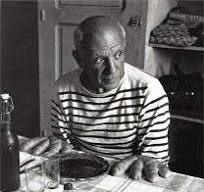 |
| Le Picador (The Bullfighter) |
Picasso's iconic shirt is a Breton-striped shirt, which in 1858 became the official uniform for French seamen in Brittany. Picasso was also a leader in fashion. His Breton striped t-shirt was designed by Coco Chanel. The 21 horizontal stripes represent each of Napoleon's victories.
Cubism is considered to be the first true abstract art style. Initially, Cubism was considered scandalous, because it didn't objectively replicate reality. Instead, it transformed natural shapes into exaggerated geometric ones. One of the first critics of this art style said that it looked like it was made up of cubes. This is what led to the label Cubism.
The cubist painters used very few colors, because they wanted the viewer to concentrate on the shapes. They often used only shades of black, brown, cream, green, blue and grey.
 |
| Girl with Mandolin - 1910 |
The model for this picture is a naked female holding a mandolin. The viewer can only see the top part of her body, from thighs to head. The head is turned to the left, which is the viewer's right. We see a profile view of the lady's face as she looks down at her mandolin slightly, which she is holding across the front of her body, apparently playing it. Note that there isn't a single bright color that stands out.
Picasso breaks down the picture into numerous rectangles, cubes, squares and other geometric shapes. He then arranged these different shapes to reveal various parts of her anatomy that would not have been possible to see in a single moment of time and from a single point in space. In other words, it shows multiple points of view in the same painting simultaneously.
 |
| Three Musicians |
Picasso paints three musicians made of flat, brightly colored, abstract shapes in a shallow box-like room. The figures represent Picasso and two of his poet friends. Guillaume Apollinaire who died three years earlier, and Max Jacob who had joined a monastery earlier that year. Picasso is the figure wearing the bright diamond patterned suit in the center. The white figure on the left is Apollinaire, and the dark figure of a monk on the right represents Max Jacob. The figure on the left plays the clarinet (cone-shaped head), the figure in the middle (dome shaped head) plays the guitar, and the monk on the right (slanted shaped head) holds sheets of music as he sings.
There's a fourth figure in the painting. One has to really look hard and long to see the brown dog stretched out onto its stomach with its legs facing the left side of the canvas. The dog's back leg touches the white pant leg of the clarinetist. Note the black silhouette of a dog's head with two pointy ears. This could either be the shadow of the first dog or another dog in the background. If I hadn't read the analysis of this painting, there's no way I'd ever have noticed the dog(s). How 'bout you?
Personally, this is not a style of art that appeals to me. However, this is a learning adventure, so we will continue to find out more about the style of the paintings and their artist, Pablo Picasso.
I'll close today's post with a bit of Picasso trivia: While Picasso is best known by his last name, his full name is 25 names long. At his baptism, he was christened as Pablo Diego Jose Francisco de Paula Juan Nepomuceno Crispin Crispiniano Maria de Los Remedios de la Santisima Trinidad Ruiz Picasso. His long name is a mixture of relatives' and saints' names. Ruiz was his father's surname, Picasso his mother's.
Pablo's family was best known as glovemakers. It was not the occupation a revolutionary artist wanted to be associated with, so he took matters into his own hands. He changed his last name to his mother's maiden name, Picasso.

